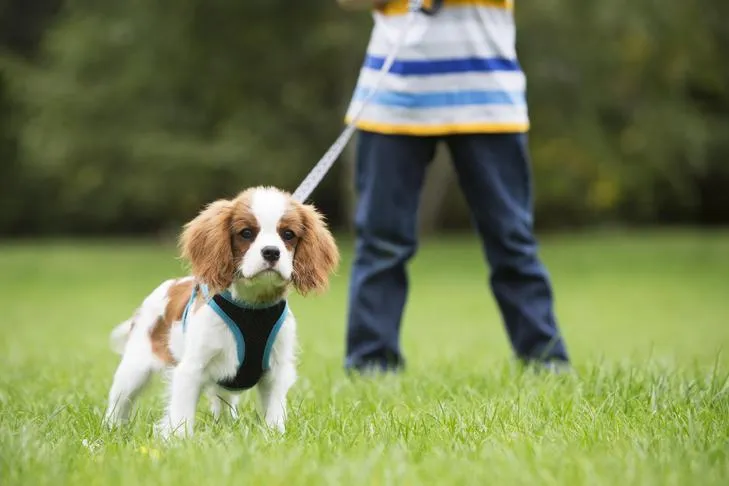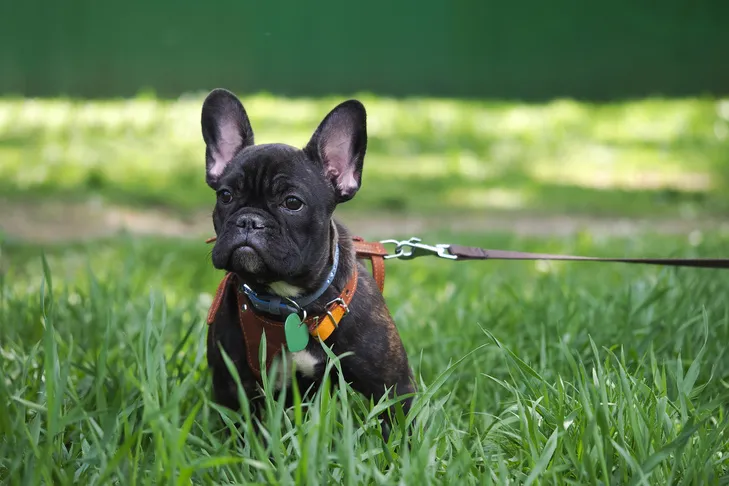Taking your puppy for regular walks is crucial for their physical exercise and vital socialization. However, many puppies aren’t born knowing how to walk on a leash, and some simply refuse to budge once the leash is clipped on. This can be a frustrating experience for new pet parents wondering How To Get Your Puppy To Go For A Walk. The truth is, many puppies are frightened, either by the unfamiliar sensation of the collar and leash or by the overwhelming stimuli of the great outdoors. Understanding these fears is the first step in transforming your hesitant pup into an enthusiastic walking companion.
For puppies, the collar and leash can feel strange and restrictive. If a puppy associates the collar with being grabbed or pulled, it can develop a negative perception. The goal is to help your puppy feel comfortable and confident wearing these essential tools, associating them with positive experiences rather than confinement. Just as you might teach your puppy basic manners, like how to manage their excitement, you’ll need to teach them to embrace their walking gear. how to get your dog from jumping is another behavior that benefits from patient, positive reinforcement.
Teach Your Puppy to Love the Leash
Simply clipping on a leash can be enough to shut some puppies down. That’s because a leash is a form of restraint. When your puppy is leashed, they can’t go where they want or escape from anything that frightens them. That feeling can be intimidating. Rather than seeing the leash as the predictor of an exciting walk, they may see it as scary. For some puppies, even a collar can upset them initially.
Hopefully, your breeder will have introduced your puppy to a collar and leash. But if not, it’s your job to help your puppy feel confident wearing them. Start in the house with short periods of time. Praise and play with your puppy while they’re wearing them and feed delicious treats as a reward. You can also play the “Gotcha” game with the collar by gently grabbing your puppy’s collar before feeding a favorite treat. In no time, your puppy will see the collar and leash as a predictor of wonderful things.
Now you’re ready to teach your puppy to walk on a leash. While still in the house, use treats to lure your puppy towards you while they’re clipped to the leash. Praise and reward your puppy when they come to you. Next, start walking with your puppy. If they’re hesitant, lure them with treats. When your puppy will walk with you in the house, try the backyard before moving to the sidewalk. Keep your sessions short with frequent praise and rewards, ensuring each experience is positive.
 A young boy gently walking a King Charles Cavalier Spaniel through a sunny field.
A young boy gently walking a King Charles Cavalier Spaniel through a sunny field.
Socialize Your Puppy to the Outdoors
When you move your training outside, remember that the great outdoors can be more than some puppies can handle. All the sights, sounds, and smells can be overwhelming, leading to anxiety or a refusal to move. Proper socialization will help conquer your puppy’s anxiety and build confidence in new environments. This gradual exposure is key to helping them adapt and learn that the outside world is not a threat.
Introduce your puppy to people of all shapes, sizes, and ethnicities. Don’t forget about all the ways people can look different to a dog, such as wearing glasses, using wheelchairs, or sporting hats. You’ll also need to expose your puppy to many different dogs and environments. However, never force any of these encounters. Let your puppy initiate contact and move at their own pace. Keep things positive and pair new outdoor experiences with play, praise, and treats. This will help your dog become comfortable with the world and to see other people and dogs as friends rather than threats. It’s similar to teaching them to be confident when you’re not around; how to train a puppy to be alone requires a patient, incremental approach to build security.
 A French Bulldog puppy wearing a harness and leash, sitting attentively in tall green grass.
A French Bulldog puppy wearing a harness and leash, sitting attentively in tall green grass.
Teach Your Puppy to Love Walks
Your first walks outside should be all about fun. Don’t worry about teaching your puppy to heel immediately. Encourage them to explore and sniff. Give your dog the best walk possible by not rushing bathroom behavior or pulling on the leash. Remember, a leash is for safety, not for control. Your puppy won’t learn to love the leash if you use it to pull them around. Focus on making the experience enjoyable and stress-free.
At first, your puppy will most likely drag their heels and pull backward rather than pull you forwards. Don’t worry about how to teach your puppy how to walk on a loose leash until they’re happy to walk and move forward on their own. If you keep things positive and fun, in no time your puppy will feel excited to take walks. Then, you can worry about training polite walking behavior. Just as with teaching them manners like how to teach your puppy to stop jumping, patience and consistency are paramount.
 A young Beagle puppy walking on a leash through green grass, looking inquisitive.
A young Beagle puppy walking on a leash through green grass, looking inquisitive.
Tips to Get Your Puppy Walking
If you’re still struggling to get your puppy moving on a leash, try the following tricks to encourage forward momentum and positive associations. Sometimes a change of scenery or a special incentive can make all the difference, helping your pup overcome any lingering hesitation and embrace the adventure of a walk. These strategies can be particularly helpful when addressing specific behavioral challenges.
- Walk Backwards to Home: Carry your puppy 20 or 30 feet away from home and let them walk back on their own. Your puppy will experience all the same things they would walking away from home. However, knowing they’re returning to safety will encourage them to keep moving.
- Short Drives: Drive a block or two from home and walk your puppy back to the house. This subtly introduces them to the concept of walking without the initial pressure of leaving the immediate home territory.
- New Locations: Drive to a new location. A different area, a quiet park, or a pet store that allows dogs inside are all perfect places to socialize your puppy. Plus, not having the house in sight might help your puppy to explore rather than retreat.
- Exciting Destinations: Have a favorite person or dog stand on the sidewalk away from your home. That will give your puppy something exciting to walk towards.
- High-Value Rewards: As a reward, choose a high-value treat or toy that your puppy only gets on walks. They’ll be tempted to walk to earn this special goodie. This creates a strong positive association with the act of walking. Just as with how to train my dog to stop jumping, consistent rewards reinforce desired behaviors.
- Positive Training Class: Enroll in a positive dog training class. It’s a great way to socialize your puppy, plus you’ll get hands-on assistance tailored to your puppy’s specific needs from expert trainers.
Whatever techniques you need to try, stay upbeat during your walks. Your puppy will sense your emotions, so if you get worried or frustrated, it’ll impact their perception of the experience. Keep your walks short and fun, and always end every walk on a positive note. It might take weeks, but every step you make together will get you closer to your goal. In time, your puppy will be walking with enthusiasm and confidence, ready to explore the world with you.
